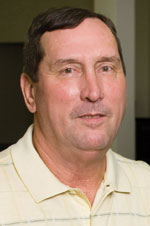Family Matters
The exact numbers aren’t clear, but it’s safe to say that the LBM industry at least follows, if perhaps exceeds, the percentage of all U.S. businesses that are family owned. According to the Survey of Business Owners conducted by the U.S. Census Bureau in 2002 and released in 2006, 28% of all companies are family owned, though the Small Business Administration puts that number far higher at about 90%. A straw poll by the National Lumber and Building Material Dealers Association in 2005 found 40 of 45 dealers surveyed fit that description.
Peter Ganahl, president and COO, has been working for nearly five years on management and ownership succession plans that will hand the operation’s reins to his son, Peter Jr., and spread the ownership among his four children. Only Peter Jr. and his brother, Mark, work at the company, where Mark is its most successful salesperson and likely will remain in that position as his brother climbs the management ladder. Their other two siblings followed different career callings.
“All of them have to be willing and ready to be owners, even if two of them aren’t involved in [running] the business,” says Ganahl, as a hedge against selling the company to outsiders once he retires. “You have to prepare the family if you want to protect the enterprise.”
Ganahl’s preparation began in 2004 with quarterly family meetings that honed how the relatives could work together in the future. “We had to get on the same page regarding our family mission, values, and working relationships,” he says. “That’s 90% of the work. The rest is easy once you have that settled.”
Concurrently, Ganahl sketched out a plan in the event that he or his brother suffered an untimely death, and if members of the current senior management team retired at age 65. The exercise exposed the need to aggressively find and hire the talent to replace them, regardless of market conditions.
“We have to be ready and willing to pick up good prospects, even in slow times,” he says.
Ganahl also mapped a personal exit strategy that bequeaths his shares in the company to the younger generation, rather than selling them, thus requiring him to secure enough personal wealth from assets and investments outside the business to retire within the next several years. Cashing in to an outsider, he says, is not an option.
Ganahl Lumber is following a script that Rivers advocates for family-owned and closely held businesses looking to keep it that way. “A comprehensive strategic plan will naturally consider management and ownership succession questions,” he says, which leads to more refined plans for each.
“The next generation should always stand on the shoulders of the one before it,” Rivers says. Younger successors, he says, don’t necessarily have to start at the loading dock to gain perspective and earn the respect of nonfamily employees. “If they have a degree, and especially if they’ve worked somewhere else, they’re already at a higher level than the founder who started from scratch,” he says, adding that kids likely did some dirty work in the family business during part-time summer jobs. “There’s no need to put a shovel in the hands of an Ivy League MBA.”
Still, some next-generation would-be managers and owners feel the pressure to prove their worth to the rank and file. “I felt the boss’ kid syndrome and worked twice as hard to dissuade it,” says Casey Voorhees, whose father founded Eugene Planing Mill in Eugene, Ore. “You have to show [employees] that you are willing to work alongside them, not above them just because you’re in the family.”
Voorhees, executive director of the Western Building Material Association in Olympia, Wash., for the last 17 years, also benefited from an exchange brokered by his father and a dealer in Alaska, one in which Voorhees went north to work in that yard while the other owner’s son came to Eugene.
“I saw things done differently than in my father’s business, and was able to bring some new ideas back,” he says. “If you have that opportunity, especially with the plan to come back and take over the family business, take it.”
In addition to placing family members in management positions that align with an education, experience, and passion to follow the founder’s footsteps, Rivers also suggests that the next generation buy its way into ownership rather than inheriting it.
“There are all sorts of elaborate plans that transfer ownership without out-of-pocket costs,” he says, “but then the next generation isn’t as vested in the ownership,” which can temper their stewardship.
To get there, Rivers suggests a 10-year plan that coincides with the presumed successors taking over the business in their early to mid-40s, giving them enough time to both learn and assume management responsibilities and make the necessary ownership investment, but still young enough to put their own stamp on the business.
Once the transition is complete–with real authority, accountability, and ownership passed to the succeeding generation–it’s essential for the outgoing owner to find a new path. In some cases, says Rivers, the founder might apply his or her entrepreneurial skills to starting a new business unit within the company (think installed sales or manufacturing), though the best course may be to make a clean break.
“It’s their chance to look outside the business for the first time in a long time,” he says. “There’s no shortage of things to do.”

